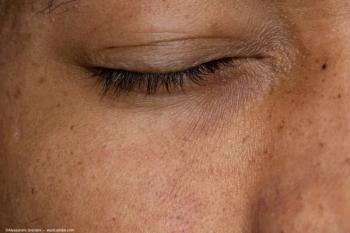
Eye drops restore and maintain ocular surface health
Multiple studies evaluating the effects of treatment with Systane Lubricant Eye Drops (Alcon Laboratories) on corneal staining in patients with dry eye disease demonstrate this novel artificial tear has benefits for improving ocular surface health.
Key Points
Scottsdale, AZ-A composite analysis of data from randomized, double-masked, controlled studies evaluating treatment of patients with dry eye disease shows that use of a novel artificial tear (Systane Lubricant Eye Drops, Alcon Laboratories) significantly improves corneal staining after 6 weeks. These results are consistent with the findings of a third study that showed rapid worsening of ocular surface health after discontinuation of successful treatment with the drop, said Stephen M. Cohen, OD.
"We know that there is no single definitive sign, symptom, test, or treatment for dry eyes, and that signs and symptoms often do not correlate with each other. However, corneal staining and tear film break-up time are the most common objective observations used to diagnose dry eye disease and assess treatment progress," said Dr. Cohen, an optometrist in private practice in Scottsdale, AZ, and an investigator in the randomized studies.
"The challenge for most dry eye products is to optimize dwell time without causing sustained blur on instillation. I have found that [this drop] provides the best balance of extended dwell time while minimizing blur after instillation. The extended dwell time often has been referred to as a 'power nap' for the cornea, during which there is slowing of the chronic epithelial damage and time allowed for epithelial restoration. In the prospective clinical studies, these benefits of [this drop] were demonstrated as improvements in corneal staining over time."
In both studies, patients were randomly assigned to four-times-daily treatment with the drop or a competitor artificial tear. At baseline, mean sum of corneal staining score for patients in the novel drop group was 4.9 in Study 1 and 5.4 in Study 2. After 6 weeks, the mean sum of corneal staining scores was significantly reduced in both trials (Study 1, 52%; Study 2, 35.2%). With the data from both studies pooled, the mean change from baseline was 47.4%, which also was a statistically significant decrease.
The discontinuation study had an open-label design. At the time of enrollment, patients were using the drop an average of 2.1 times per day and had a mean sum of corneal staining score of 2.0. They were followed prospectively and corneal staining was re-evaluated at weekly visits. Overall, 15 patients withdrew prematurely from the planned 5-week follow-up, including two patients who discontinued study participation after just 1 week. Mean time to study exit was 3.5 weeks, and analysis of data from the exit visit showed that the mean sum of corneal staining score increased significantly from 2.0 at baseline to 5.9.
"These findings indicate patients with dry eye disease need to maintain use of their artificial tear product on a regular basis to prevent return of corneal staining," Dr. Cohen said.
Among artificial tear products, this studied drop represents a novel formulation that contains active demulcents, polyethylene glycol and propylene glycol, the gelling agent hydroxypropyl (HP)-guar, and borate. On instillation, HP-guar interacts with the borate ions to form a stable, polymer gel matrix. The borate cross-links provide a bonding with the epithelium, extending the duration of surface coverage.
"This allows for greater surface repair of the epithelium in patients using [this drop], much as a bandage might provide. As a result, [this drop] provides both short-term symptomatic relief as well as longer-term enhancement of ocular surface protection and healing," he said.
"I have found it to be an extremely dependable option for patients with dry eye across the full range of disease severity," he concluded.
Newsletter
Don’t miss out—get Ophthalmology Times updates on the latest clinical advancements and expert interviews, straight to your inbox.


















































.png)


